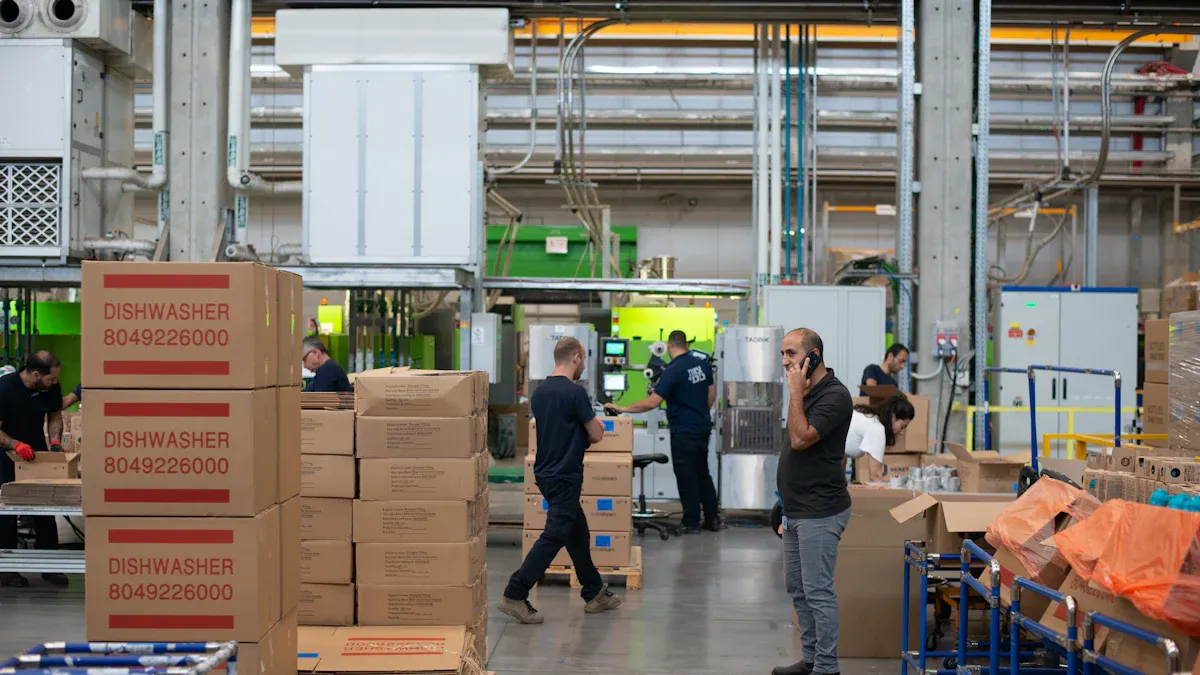A Beginner's Guide to MES and WMS Selection for 2025

When it comes to modern manufacturing, MES (Manufacturing Execution Systems) and WMS (Warehouse Management Systems) play a vital role. MES helps you monitor and control production processes, while WMS ensures efficient warehouse operations. Together, they streamline workflows, reduce errors, and improve productivity.
Choosing the right systems for 2025 is more important than ever. Digital transformation is reshaping industries, and having the right tools can give you a competitive edge. But for small-medium manufacturers, adopting MES WMS systems isn’t always straightforward.
You might face challenges like limited budgets, scalability issues, or the need for customized solutions. Data accuracy and duplication can also become a headache, especially when integrating multiple systems. Plus, relying on vendor support or ensuring compatibility with third-party applications can complicate things further.
By understanding these hurdles and planning carefully, you can set your business up for success in the digital age.
Key Considerations for First-Time MES WMS Selection
Scalability and Future-Proofing
When choosing MES WMS systems, you need to think long-term. A system that works today might not meet your needs tomorrow. That’s why scalability and future-proofing are essential. Look for solutions that can grow with your business. For example, systems with scalability features can handle increased production or new product lines without requiring a complete overhaul.
Customization is another key factor. Tailoring the system to your specific operations ensures it aligns with your workflows. Also, check if the system supports integration with other tools you might adopt in the future. Don’t forget about regulatory compliance. A system that meets industry standards today will save you headaches down the road. Most importantly, make sure the system aligns with your long-term business goals.
Tip: Think of MES WMS as an investment in your future. A little extra planning now can save you from costly upgrades later.
Integration with Current Systems
MES WMS systems work best when they play nicely with your existing tools. Integration ensures a seamless flow of information across your operations. For instance, integrating MES with WMS can enable dynamic inventory management, ensuring materials are available just in time for production. Similarly, connecting MES with Laboratory Information Management Systems (LIMS) can streamline quality control processes.
Some businesses also link WMS with ERP systems to create a unified platform. This setup allows data to flow effortlessly from production to distribution. For example, an automotive parts manufacturer might use WMS to manage inventory across multiple warehouses, syncing it with production schedules. This kind of integration reduces lead times and supports just-in-time production.
Budget and Cost Management
Budgeting for MES WMS systems can feel overwhelming, but breaking it down helps. Costs vary depending on the functionality you need. For small-medium businesses, entry-level SaaS systems might cost around $100 per user per month, while mid-range options could go up to $300. If you prefer a perpetual license, expect to pay anywhere from $2,500 to $50,000, depending on the system’s complexity.
Installation costs also add up. On-premise systems might cost $2,000 for basic setups or $10,000 for enterprise-level platforms. SaaS systems often come with setup fees, averaging $5,000 for mid-range solutions. To manage costs, prioritize features that directly impact your operations and avoid overpaying for unnecessary extras.
Note: While cost is important, don’t let it overshadow the value a well-integrated MES WMS system can bring to your business.
User-Friendliness and Training
When selecting MES WMS systems, user-friendliness should be a top priority. A system that’s easy to navigate saves time and reduces frustration for your team. Look for an intuitive interface that doesn’t require a steep learning curve. Employees should be able to pick up the basics quickly, even if they’re not tech-savvy.
Training is another critical factor. A great system won’t deliver results if your team doesn’t know how to use it. Check if the vendor offers comprehensive training programs. These could include on-site sessions, online tutorials, or even interactive workshops. Some vendors also provide ongoing training to help your team stay updated as the system evolves.
Tip: Ask vendors if they offer role-specific training. For example, warehouse staff might need different guidance than production managers.
You should also consider the system’s adaptability. Can it accommodate new employees or changes in your workflow? A flexible system ensures your team can keep up as your business grows.
Vendor Reliability and Support
Choosing a reliable vendor is just as important as picking the right system. You need a partner who will support you when challenges arise. Start by evaluating their customer support. Do they offer 24/7 assistance, or are they only available during business hours? Multiple support channels like phone, email, and chat can make a big difference when you need help fast.
A dedicated account manager or support team is another plus. They can provide personalized assistance and ensure your issues are resolved quickly. Don’t forget to check the vendor’s reputation. Look for customer reviews and testimonials to see how they’ve performed for other businesses.
Here’s a quick checklist to evaluate vendor reliability:
Do they offer intuitive and user-friendly systems?
Can their solutions meet your current and future needs?
Are their systems compatible with your existing tools?
Do they provide reliable support and maintenance services?
Is their pricing transparent and within your budget?
Note: A trustworthy vendor will act as a long-term partner, helping you get the most out of your MES WMS investment.
Understanding MES WMS and Their Roles

What is MES and Its Purpose?
A Manufacturing Execution System (MES) is like the brain of your production floor. It helps you manage and monitor everything happening during manufacturing. From scheduling tasks to tracking products, MES ensures your operations run smoothly.
Here’s a quick look at what MES can do for you:
Function | Description |
|---|---|
Resource Management | Manage maintenance and schedules for production facilities and equipment. |
Quality Control | Supports quality control based on collected measurement data. |
Scheduling | Create detailed work schedules and employee assignments. |
Data Collection | Collect data for each process and display progress in real time. |
Product Tracking | Manage storage location and movement of products. |
Performance Analysis | Analyze production status and compare with past performance. |
By using MES, you can reduce waste, improve quality, and even eliminate labor shortages. It also helps you stay on top of production schedules and ensures traceability for better compliance.
Tip: MES is a great tool if you’re looking to digitize your processes and move away from paper-based systems.
What is WMS and Its Purpose?
A Warehouse Management System (WMS) focuses on your warehouse operations. It’s designed to optimize how you store, track, and move inventory. Think of it as the backbone of your supply chain.
Here’s how WMS can benefit your business:
Automates inventory tracking and goods retrieval to reduce costs.
Improves order fulfillment speed and accuracy by streamlining picking and packing.
Provides real-time insights into warehouse operations for better decision-making.
Scales easily to meet changing business demands.
Ensures compliance by maintaining accurate records.
For example, WMS can assign tasks to warehouse staff based on their skills and availability. This ensures efficient use of labor and reduces operational costs.
Key Differences Between MES and WMS
While MES and WMS systems complement each other, they serve different purposes. MES focuses on production, while WMS handles inventory and warehouse management.
Functionality | MES | WMS |
|---|---|---|
Role in Production | Intermediate layer between ERP and production | Manages inventory and BOM |
Real-time Stock Control | Coordinates with WMS for production lines | Controls available stock in real time |
Order Management | Receives manufacturing orders from WMS | Sends manufacturing orders to MES |
In short, MES ensures your production runs efficiently, while WMS keeps your inventory organized. Together, they create a seamless flow from manufacturing to distribution.
Note: MES WMS integration can significantly enhance your operations by aligning production and inventory management.
How MES and WMS Complement Each Other
When you combine MES and WMS, your manufacturing and warehouse operations can work like a well-oiled machine. These systems complement each other by ensuring smooth communication between production and inventory management. Together, they help you avoid delays, reduce waste, and improve overall efficiency.
MES and WMS software work in sync to guarantee that material flows from the installation to the production center and vice versa occur without interruptions and with maximum efficiency.
Here’s how they work together:
WMS manages the BOM (bill of materials) and controls available stock in real time.
WMS sends manufacturing orders to the MES software when new orders are received.
WMS reports inventory consumption and records finished products to avoid stockouts.
Imagine this: your WMS tracks raw materials in your warehouse. When stock levels drop, it alerts the MES to adjust production schedules. At the same time, MES updates the WMS with real-time data about finished goods. This back-and-forth communication ensures you always have the right materials at the right time.
By integrating these systems, you can also improve traceability. MES tracks production processes, while WMS monitors inventory movement. If there’s ever an issue, you can quickly trace it back to its source. This level of visibility helps you maintain quality and meet compliance standards.
In short, MES WMS integration creates a seamless flow of information. It bridges the gap between production and inventory, helping you run your operations more effectively.
Actionable Strategies for MES WMS Selection
Define Your Business Objectives
Before diving into MES WMS selection, you need to define your business objectives clearly. This step ensures you choose a system that aligns with your goals. Start by assessing your current state. Review your existing application landscape, including tools like your ERP. This will help you identify gaps in your processes and pinpoint areas where MES or WMS can add value.
Next, think about the information you want to manage with these systems. For example, do you need better production tracking or improved inventory control? Finally, consider future shop floor activities. Could an MES extension improve efficiency down the line? By answering these questions, you’ll create a roadmap that guides your selection process.
Tip: Write down your objectives and share them with your team. This ensures everyone stays on the same page during the selection process.
Evaluate Vendors and Solutions
Not all vendors are created equal. To find the right partner, evaluate them based on specific criteria. Look for systems that offer customization options. A good system should adapt to your workflows, not the other way around. Integration capabilities are also critical. The system must work seamlessly with your existing tools to avoid disruptions.
Scalability is another must-have. Choose a solution that grows with your business. Don’t forget about regulatory compliance. Features like traceability and documentation can save you from future headaches. Beyond the system itself, assess the vendor’s overall viability. Are they reliable? Do they have a strong track record?
Here are some key factors to consider:
Customer experience and support quality.
Market responsiveness and ability to keep up with trends.
Transparent pricing and sales execution.
Note: A vendor who understands your industry can offer tailored solutions that maximize value.
Assess Features and Capabilities
When comparing MES WMS systems, focus on features that directly impact your operations. Robust security features like data encryption and user authentication are essential. Real-time analytics and reporting capabilities provide actionable insights, helping you make informed decisions.
For WMS, look for inventory tracking, order management, and labor management tools. Shipping and receiving features can streamline logistics, while quality assurance ensures your products meet standards. Advanced reporting and integration capabilities are also valuable for long-term success.
Tip: Prioritize features that align with your long-term business goals. This ensures the system remains relevant as your needs evolve.
Plan for Implementation and Change Management
Implementing MES and WMS systems can feel overwhelming, but a solid plan makes all the difference. Start by creating a clear strategy. Define your goals and ensure they align with your business objectives. For example, are you looking to improve production efficiency or streamline inventory management? Knowing your priorities helps you stay focused.
One of the biggest challenges during implementation is ensuring data accuracy and consistency. You’ll need to clean up your existing data and verify its reliability before migrating it to the new system. Integration with other tools, like ERP or supply chain management (SCM) systems, is also critical. Without proper integration, you risk creating operational silos that slow down your processes.
Change management plays a huge role in a smooth transition. Employees might resist new systems, especially if they’re unfamiliar with the technology. That’s why training is so important. Comprehensive training programs can address workforce concerns and help your team feel confident using the new tools.
Tip: Break the implementation into smaller phases. This approach minimizes disruptions and gives your team time to adapt.
Finally, don’t overlook data security and compliance. Protecting sensitive information ensures your operations run without interruptions. A secure system also helps you meet industry regulations, saving you from potential penalties.
Engage Stakeholders in the Process
Getting your stakeholders involved early can make or break your MES WMS project. When everyone is on the same page, you avoid confusion and resistance. Start by identifying key stakeholders, like department heads, IT teams, and end-users. Each group brings unique insights that can shape the system to fit your needs.
Hold regular meetings to discuss goals, benefits, and potential challenges. This keeps everyone informed and engaged. For example, production managers might highlight specific pain points that the MES could solve, while warehouse staff could suggest features to improve inventory tracking.
Note: Stakeholder alignment ensures the system meets real-world needs, not just theoretical ones.
Encourage open communication throughout the process. When stakeholders feel heard, they’re more likely to support the project. You can also assign champions within each department to act as liaisons. These champions can gather feedback, address concerns, and keep their teams motivated.
By involving stakeholders, you create a sense of ownership. This not only boosts adoption rates but also ensures the system delivers maximum value for your business.
Overcoming Challenges in MES WMS Adoption
Addressing Resistance to Change
Resistance to change is one of the biggest hurdles when adopting new systems like MES WMS. Employees often feel uneasy about altering their routines. Some may worry that automation could threaten their job security. Others might struggle with a complex interface or feel left out of the decision-making process.
To tackle this, involve your team early. Let them share their concerns and ideas. When employees feel heard, they’re more likely to embrace the change. Training also plays a huge role. Make sure everyone knows how to use the system effectively. Offer hands-on sessions or online tutorials to build confidence.
Keep the system user-friendly. A simple, intuitive interface reduces frustration and encourages adoption. Finally, communicate the benefits clearly. Show how the system will make their jobs easier, not harder.
Tip: Highlight success stories from other companies to inspire your team and reduce fear of the unknown.
Managing Financial Constraints
Budgeting for MES WMS adoption can feel overwhelming, especially for small-medium businesses. Costs can add up quickly, from software licenses to training and implementation. To manage this, prioritize features that directly impact your operations. Avoid paying for extras you don’t need.
Consider starting with a SaaS model. It offers lower upfront costs and flexibility to scale as your business grows. You can also explore phased implementation. Rolling out the system in stages spreads costs over time and minimizes disruptions.
Note: Don’t forget to calculate the long-term ROI. A well-integrated system can save you money by improving efficiency and reducing errors.
Ensuring Seamless System Integration
Integrating MES WMS with your existing tools is crucial for success. Start by aligning your processes. Make sure procurement, inventory management, and fulfillment workflows are in sync. Work closely with your vendor to customize the system to your needs.
Roll out the system in phases. This approach minimizes disruptions and gives your team time to adjust. After implementation, monitor performance closely. Gather feedback and make improvements as needed.
Real-time communication between systems is also key. Ensure data flows smoothly to avoid bottlenecks. For example, synchronize item catalogs and order data to maintain consistency.
Tip: Effective change management, including training and clear communication, ensures a smoother transition for your team.
Mitigating Data Security Risks
When it comes to MES and WMS systems, data security should be one of your top priorities. These systems handle sensitive information, from production schedules to inventory levels, making them attractive targets for cyberattacks. But here’s the good news—you can take steps to protect your data and minimize risks.
Did you know that most security breaches—about 95%—happen because of user errors? It’s not always the software that’s the problem. Often, it’s how people use it. To reduce this risk, you should focus on training your team. Teach them about secure password practices and how to recognize phishing attempts.
Cloud-based systems can also offer better security than traditional setups. Reports show that cloud infrastructure workloads experience nearly 60% fewer security incidents compared to on-premise data centers. If you’re considering a cloud solution, make sure the vendor provides robust encryption and regular security updates.
Here are a few more tips to keep your data safe:
Enable multi-factor authentication (MFA): This adds an extra layer of protection.
Regularly update software: Outdated systems are more vulnerable to attacks.
Conduct security audits: These help you identify and fix weak points.
Tip: Always back up your data. In case of a breach, having a secure backup ensures you can recover quickly.
By staying proactive, you can safeguard your MES and WMS systems and keep your operations running smoothly.
Avoiding Vendor Lock-In
Vendor lock-in can feel like being stuck in a bad relationship—you’re tied to one provider, and switching becomes a nightmare. When selecting MES and WMS systems, you need to plan ahead to avoid this trap.
One common issue with vendor lock-in is unexpected costs. If you don’t fully understand the total cost of ownership (TCO), you might face surprise expenses down the road. For example, upgrades or changes in APIs can complicate integrations and increase costs.
Another risk is integration challenges. If your MES and WMS come from different vendors, you might encounter system failures or compatibility issues. This can disrupt your operations and lead to downtime.
Here’s how you can avoid these pitfalls:
Choose open systems: Look for solutions that support standard APIs and protocols.
Work with a strong systems integrator (SI): An experienced SI can help you navigate vendor relationships and ensure smooth integrations.
Evaluate long-term flexibility: Make sure the system can adapt to your future needs without locking you into one provider.
Note: Ask vendors about their exit policies. Knowing how easy it is to switch providers can save you headaches later.
By taking these steps, you can maintain control over your systems and avoid being tied down by a single vendor. This gives you the freedom to adapt as your business grows.
Future Trends in MES WMS for 2025

AI and Machine Learning Integration
Artificial intelligence (AI) and machine learning (ML) are transforming how businesses operate, and MES WMS systems are no exception. These technologies can help you predict demand, optimize workflows, and even identify potential bottlenecks before they occur. Imagine having a system that learns from your data and suggests ways to improve efficiency. That’s the power of AI and ML.
For example, AI can analyze production data to forecast equipment failures, allowing you to schedule maintenance proactively. ML algorithms can also optimize warehouse layouts by studying picking patterns, reducing travel time for workers. These tools don’t just save time—they also cut costs and improve accuracy.
Tip: Start small by implementing AI-driven analytics for one process, then expand as you see results.
Cloud-Based and SaaS Solutions
Cloud-based and SaaS (Software as a Service) solutions are becoming the go-to choice for MES and WMS systems. Why? They’re cost-effective, flexible, and easy to scale.
Here’s what you can expect:
Cost Savings: SaaS solutions can be up to 30% cheaper to implement than on-premise systems.
Faster Implementation: You can get up and running quickly, which means faster returns on investment.
Scalability and Flexibility: As your business grows, these systems grow with you—no need for expensive upgrades.
Improved Resilience: SaaS systems are designed to handle disruptions better, ensuring smoother operations.
If you’re looking for a solution that adapts to your needs without breaking the bank, cloud-based systems are worth considering.
IoT for Real-Time Data Insights
The Internet of Things (IoT) is revolutionizing how you gather and use data. By connecting devices and sensors, IoT provides real-time insights that can transform your operations.
Benefit | Description |
|---|---|
IoT sensors collect data on parameters like temperature and pressure, transmitting it to the MES system for up-to-date information on production processes. | |
Continuous Monitoring | IoT devices capture data at regular intervals, enabling real-time monitoring of KPIs such as production rates and quality metrics. |
Enhanced Visibility | IoT devices track the movement of materials and products, improving inventory management and reducing errors. |
Predictive Maintenance | IoT sensors monitor equipment conditions, predicting maintenance needs and optimizing schedules to prevent unexpected breakdowns. |
With IoT, you can monitor your production floor and warehouse in real time. This level of visibility helps you make better decisions and avoid costly mistakes.
Note: IoT isn’t just about data collection—it’s about turning that data into actionable insights.
Sustainability and Green Manufacturing
Sustainability isn’t just a buzzword anymore—it’s a necessity. As a manufacturer, you’re probably feeling the pressure to reduce your environmental impact. MES and WMS systems can help you achieve this by streamlining operations and cutting waste.
For starters, MES systems let you monitor energy usage during production. You can identify inefficiencies and make adjustments to save resources. For example, if a machine consumes too much power during idle times, MES can alert you to shut it down or optimize its settings.
WMS systems also play a big role in green manufacturing. They improve inventory management, which reduces overstocking and waste. By tracking materials in real time, you can avoid expired or unused inventory. Plus, WMS can optimize shipping routes to cut fuel consumption.
Tip: Look for systems that support sustainability goals, like tracking carbon footprints or using eco-friendly packaging.
Another way these systems promote sustainability is through better data visibility. When you have clear insights into your operations, you can make smarter decisions. For instance, you might switch to suppliers with greener practices or adjust production schedules to minimize energy use.
By adopting MES and WMS systems, you’re not just helping the planet—you’re also boosting your bottom line. Sustainable practices often lead to cost savings and improved brand reputation. Customers today care about eco-friendly businesses, and your efforts could set you apart from competitors.
Industry-Specific Customization
Every industry has its quirks, and your MES and WMS systems should adapt to them. Industry-specific customization ensures these tools fit your unique workflows, making your operations more efficient.
Take food manufacturing as an example. Batch traceability is critical for compliance and safety. A customized system can track every ingredient from supplier to shelf. In medical device production, compliance tracking is equally vital. Tailored MES systems can ensure you meet strict regulatory standards without missing a beat.
This level of customization doesn’t just improve efficiency—it also saves money. When your system aligns perfectly with your needs, you avoid unnecessary features and inefficiencies. You get a solution that works for you, not against you.
Note: Investing in industry-specific customization maximizes your return on investment and keeps your operations running smoothly.
By choosing a system designed for your industry, you’ll streamline processes, reduce errors, and stay ahead of the competition. It’s a win-win for your business and your customers.
Selecting the right MES WMS systems is a game-changer for your digital transformation journey. These tools streamline operations, improve quality, and provide a centralized platform to monitor production. By choosing systems that align with your goals, you set the stage for long-term growth and scalability.
To get started, follow these steps:
Define your specific needs and prioritize features that add value.
Research vendors and assess their solutions for compatibility and usability.
Taking the time to assess your needs and explore options ensures you make an informed decision. Start today, and you’ll be one step closer to transforming your business for the future.
FAQ
What’s the difference between MES and WMS?
MES focuses on managing production processes, while WMS handles inventory and warehouse operations. MES tracks manufacturing tasks, and WMS ensures materials are stored and moved efficiently. Together, they create a seamless workflow from production to distribution.
Tip: Think of MES as managing "how things are made" and WMS as managing "where things are stored."
How do I know if my business needs both MES and WMS?
If you manage both production and inventory, you’ll benefit from both systems. MES improves manufacturing efficiency, while WMS optimizes storage and logistics. Together, they reduce errors and improve productivity.
Note: Start by identifying gaps in your current processes to see where these systems can help.
Are cloud-based MES and WMS systems better than on-premise ones?
Cloud-based systems offer flexibility, scalability, and lower upfront costs. They’re easier to update and maintain. On-premise systems provide more control but require higher initial investments and ongoing maintenance.
Tip: Choose based on your budget, IT resources, and long-term goals.
How long does it take to implement MES and WMS systems?
Implementation time varies. Small systems may take a few weeks, while complex setups can take months. Factors like system customization, data migration, and employee training affect the timeline.
Tip: Break the process into phases to minimize disruptions and ensure a smoother transition.
Can MES and WMS systems integrate with my existing tools?
Yes, most modern MES and WMS systems support integration with ERP, CRM, and other tools. Check for compatibility and open APIs when evaluating vendors.
Note: Seamless integration ensures data flows smoothly across your operations, improving efficiency.
See Also
Understanding CBAM: A Supplier's Guide to Sustainable Casting
Comprehensive Guide to CAD Design for Die Casting
Key Industrial Trends in Hunan to Monitor for 2025
Exploring QFD, FMEA, and DOE's Impact on Quality Manufacturing
Seven Essential Steps to Collaborate with Global Diecast Factories
About Hunan Puka
Established in 2016 and based in Hunan, China, with a liaison point in Berlin, we are a Tier 2 supplier for the automobile industry. We specialize in the production of customized aluminum die-casting parts designed for machines with a closing force ranging from 280 to 1250 tons, with subsequent manufacturing process CNC machining and surface treatment. Our commitment to quality is reflected in our accredited quality management system, certified by ISO9001:2015 and IATF16949:2016 standards.


